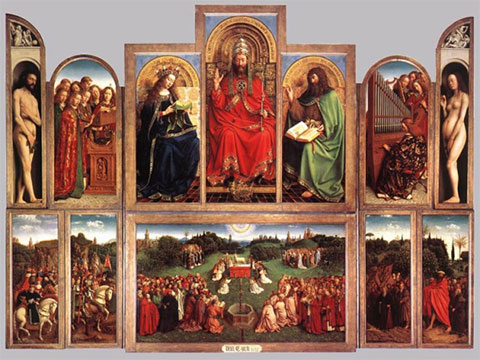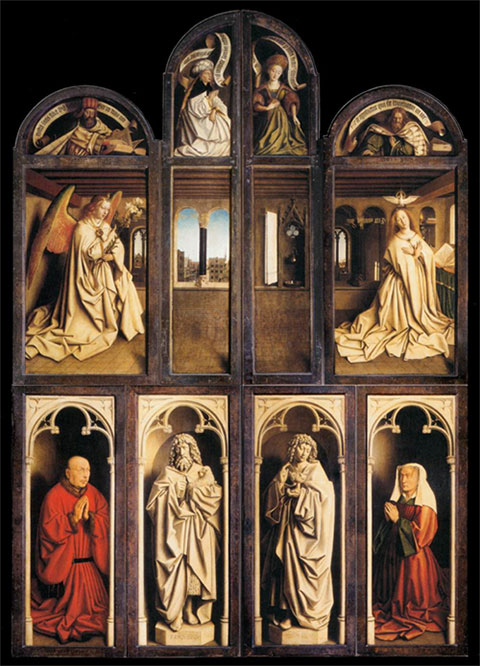

|
| Musical Musings: Easter |
|
|
The Lamb of GhentDuring Eastertide in Year C the Second Reading comes from the glorious book of Revelation, and we get an extraordinary glimpse into the liturgy and the music of heaven. George Frederick Handel, in his monumental oratorio Messiah, used this text from Revelation 5:12-14, as its concluding chorus. Some hold it to be the greatest music in the oratorio (and even beyond).
Worthy is the Lamb that was slain, to receive power, and riches, and wisdom, and strength, and honour, and glory and blessing. These words that we hear on the Third Sunday of Easter (C) inspired other artists as well. The brothers Hubert and Jan van Eyck, Belgian Renaissance painters, completed the magnificent Ghent Altarpiece in 1432, one of the first painted altarpieces in North-West Europe. Earlier altarpieces were usually woodcuts. Painted for the Vyd Chapel of the Cathedral of Saint Bavo in Ghent, Belgium, it is a masterpiece of the polyptych form — a work divided into hinged segments. In this case there are 12 panels, but each is painted on both sides, yielding 24 separate scenes.
When open, the altarpiece shows two tiers. Centered in the upper tier we see God the Father, clothed in quasi-liturgical red robes with a tri-regnum (similar to a papal tiara) on his head. On the ground before him lies a secular crown, behind which are the words:
On his head, life without death. There is speculation that this figure might also be Jesus Christ, robed in the garments of a priest, or even a mystical depiction of the Holy Trinity in a single figure, with the triple crown representing three persons. On his sash is Latin text from Revelation, translated: "King of Kings and Lord of Lords." To this figure's right sits the Blessed Virgin Mary, arrayed in deep blue with a crown on her head. To his left is Saint John the Baptist, a green cloak over his hair shirt, uttering the words, Ecce Agnus Dei, "Behold the Lamb of God." Beyond the Virgin are an octet of angelic choristers, singing from a book on a podium, with the inscription Melos Deo laus "Music in Praise of God." Beyond the Baptist we see Saint Cecilia at a pipe organ; angels with stringed instruments play with her. The text reads: Laudate eum in cordis et organo "Praise him with stringed instruments and organs." Completing the upper tier, in cold stone arches at the extremities, are the fallen Adam and Eve, naked in their sinfulness. The lower tier shows the famous "Adoration of the Lamb," in a long panel extending the length from the Virgin to the Baptist above. Standing on an altar in a green meadow, is the Lamb of God, whose Blood is being collected in a golden chalice. The dove of the Holy Spirit hovers above in a radiant cloud. Two angels incense the altar from the front, while others at the side hold instruments of the Passion: the Cross, Pillar, Nails, Lance, Crown of Thorns, by which the sacrifical victory was won. A fountain, representing the Water of Life flowing from the Lamb, is pictured in the bottom center. Four groups of saints surround the altar, facing the Lamb in adoration:
Thomas Hoving, in his Greatest Works of Art of Western Civilization, commented: The painting is renowned for how every detail is brilliantly rendered. The realism of this work is literally breathtaking and there is simply no other work in existence that can come near to the intense concentration of the utter reality of everything in the picture, but especially of the details. Everything seems to have been (and perhaps was) painted with a single-hair brush. To the left of this central panorama are two smaller panels, one showing the Just Judges; the other, Crusaders on horseback. The first panel and the panel of Saint John the Baptist were stolen in 1934. The latter was returned by the thief, but the former (the Just Judges) is still missing; it has been replaced by a replica by Belgian art restorer Jef Van der Veken. To the right are panels showing Hermits (including Saint Mary Magdalene) and Pilgrims (including Saint Christopher).
When closed, the back sides of the panels have three tiers. The upper tier show in Romanesque arches, the prophets Zachary and Micah to the outside, and the Sibyls (prophetesses) from Erythraea and Cumae in the center, representing Asia and Europe, respectively. The middle tier has two tall, narrow center panels, showing simply some of the architecture of the room, while the larger outer panels depict the Annunciation scene. The Archangel Gabriel appears to the left, winged and robed in white, holding a lily plant. The Virgin kneels in the right-most panel, arms crossed over her chest, the Holy Spirit hovering above her as a dove. Her response to God, via the Archangel, is Ecce ancilla Domini, "Behold the handmaid of the Lord," written backwards as if to be read by God, not by man. The lower panel is divided into four equal spaces, the inner two showing Saint John the Baptist (holding a lamb) and Saint John the Evangelist (holding a chalice). The former is the patron of the cathedral of Ghent; the latter is the author of the Book of Revelation, wherein is found the inspiration for the main panel on the reverse, the Adoration of the Lamb. These two are painted as if statues, standing in gothic-arched niches. To the outside kneel the donor, Jodocus Vijd, and his wife, Isabel Borluut. There seems to have been an ornate wooden frame, carved to mimic the painted tracery of the panels. This was destroyed during the Reformation. It may have included a gear mechanism for opening and closing the panels and may even have played music. In World War II, Hitler seized this altarpiece and stored at in Neuchwanstein Castle in Bavaria and later in a salt mine. An allied group called the Monuments, Fine Arts and Archives Program recovered the painting. The story is told in the 2014 movie, "The Monuments Men," starring George Clooney, Matt Damon, Bill Murray, John Goodman, and Cate Blanchett. Article written 22 March 2016 |
Submit Your Music / Contact Us / Company Description / Links

